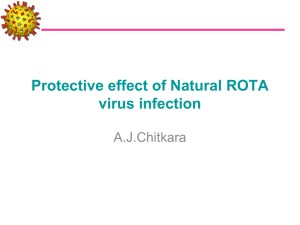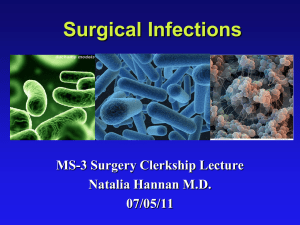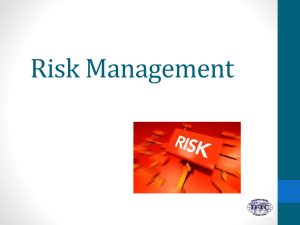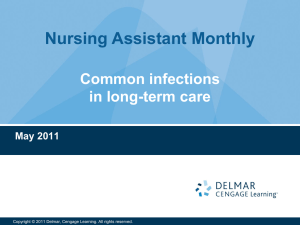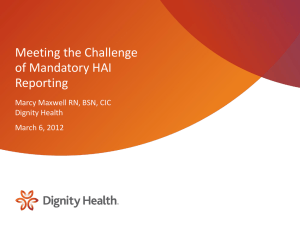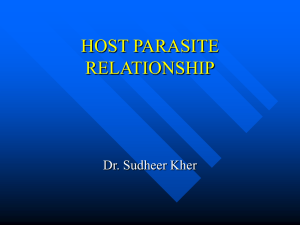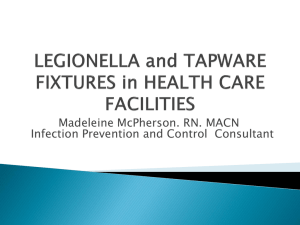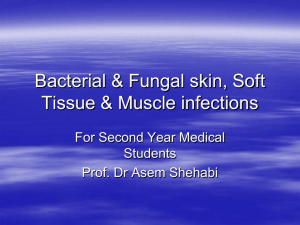Infection Prevention and Control - International Federation of
advertisement
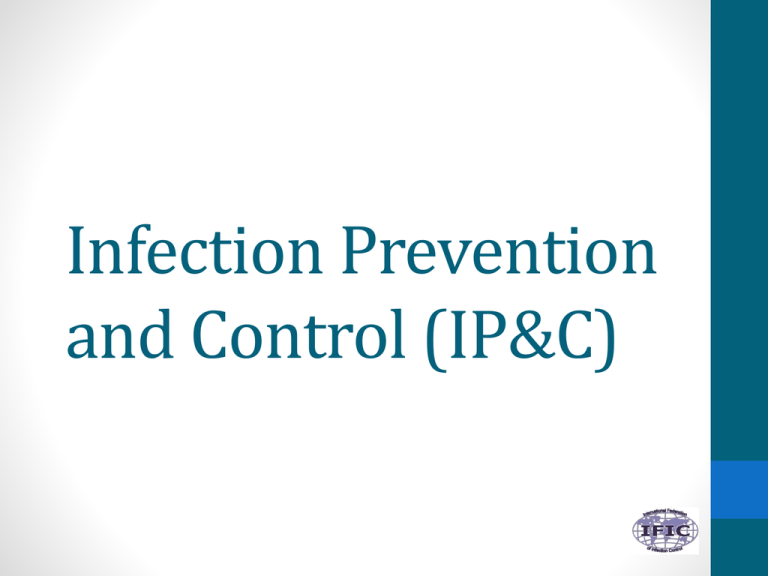
Infection Prevention and Control (IP&C) 1. Outline the history of infection prevention and control. 2. Describe the goals of infection prevention and control programs. 3. Discuss how an IP&C program can make a positive impact in any healthcare organization. December 1, 2013 Learning objectives 2 • 35 minutes December 1, 2013 Time involved 3 • The discipline concerned with preventing nosocomial or healthcare-associated infections • a sub-discipline of epidemiology December 1, 2013 What is IP&C? • Similar to public health activities, mainly practiced within a health-care delivery system • Focuses on evidence-based practices and procedures that can prevent or reduce the risk of transmission of microorganisms to health care providers, clients/patients/residents and visitors 4 • Infections are a leading cause of morbidity and mortality in healthcare settings • Infections can cause pain, suffering and often, permanent scarring • Infections cause prolonged hospital stays which has an impact on costs December 1, 2013 Why is IP&C Important? 5 • Pre 1800: Early efforts at wound prophylaxis • 1800-1940: Nightingale, Semmelweis, Lister, Pasteur • 1940-1960: Antibiotic era, S. aureus outbreaks in nurseries • 1950-1970: Surveillance begins, documentation of need for infection control programs, infection control committees develop • 1980: HIV issues, resistant bacteria, SENIC study and NNIS in USA • 1990: Blood-borne pathogens • 2000: Pandemics, patient safety December 1, 2013 History 6 • The first infection prevention and control champion • Research into hospital sanitary problems made her a firm believer in pure air, pure water, efficient drainage, cleanliness, and light • Nightingale’s firm belief in preventive medicine led to an established standard of formalized cleanliness and sanitation in hospitals and the military December 1, 2013 Florence Nightingale 7 • Demonstrated that routine hand washing could prevent the spread of puerperal fever • Noted that maternity patients were dying at such an alarming rate that they begged to be sent home from the hospital to deliver with a midwife • Semmelweis’ analysis revealed that medical students, responsible for deliveries in Division I, often performed autopsies before assisting in deliveries, while midwives, who worked in Division II, did not December 1, 2013 Ignaz Semmelweis - 1 8 • Theorized that disinfecting hands could prevent transmission of infection from a diseased cadaver to a pregnant patient • Required medical students to wash their hands with chlorinated lime before assisting in deliveries December 1, 2013 Ignaz Semmelweis - 2 • Resulted in a dramatic outcome - deaths on the maternity ward fell fivefold 9 • Troubled by high mortality rates from post-surgical sepsis • First to see the connection between Pasteur's discoveries of the fermentation process and the suppuration of wounds December 1, 2013 Joseph Lister - 1 10 • In 1867 he published his paper on antisepsis, stating that • "all the local inflammatory mischief and general febrile disturbance which follow severe injuries are due to the irritating and poisoning influence of decomposing blood or sloughs." • He began applying carbolic acid to compound fracture wounds • The wounds healed, amputation averted, and the mortality rate plummeted from 45% to 15% December 1, 2013 Joseph Lister - 2 11 • The earliest formal programs were in the 1950s • Began as an effort to address issues like staphylococcal epidemics • The first Infection Control Nurses were appointed at this time; they often had a background in bacteriology • Surveillance of hospital infections was instituted and policies and procedures developed • Early infection control programs focused on environmental cleanliness • Antimicrobial resistant pathogens became a concern in the 1970s December 1, 2013 Infection Prevention and Control Programs 12 • HAIs include urinary tract infections, pneumonia, bloodstream infections and surgical site infections • The WHO states December 1, 2013 Healthcare-Associated Infections (HAI) - 1 • urinary tract infection is the most frequent HAI in highincome countries; surgical site infections in settings with limited resources* 13 * Statistics in low resource countries are often nonstandardized or incomplete • 30% of patients in intensive care units (ICU) are affected by at least one HAI in high-income countries December 1, 2013 Healthcare-Associated Infections (HAI) • In low- and middle-income countries the frequency of ICU-acquired infection is at least 23 fold higher* • Newborns are at higher risk of acquiring HAI in developing countries, with infection rates three to 20 times higher than in high-income countries* 14 * Statistics in low resource countries are often nonstandardized or incomplete • To prevent the spread of infections from • • • • patient-to-patient patients to health care providers health care providers to patients health care providers to health care providers and to visitors and others in the health care environment December 1, 2013 Goals of IP&C CONSEQUENTLY • To protect patients from HAIs, resulting in • • • • improved survival rates reduced morbidity associated with infections shorter length of hospital stay a quicker return to good health 15 • To obtain and manage critical data and information • To implement evidence-based practice, standards and guidelines through setting-specific policies and procedures • To intervene directly to prevent infections • To provide effective occupational health programs • To educate and train healthcare workers, patients, and non-medical caregivers • To provide communication of infection-related issues and relevant practices to leaders and staff to facilitate improvements • To evaluate the program and improve it as necessary December 1, 2013 Functions of IP&C 16 • Surveillance • Outbreak investigations • Prevention through practices/guidelines December 1, 2013 Practice of IP&C Today • hand hygiene, use of barriers, isolation/precautions, construction/renovation, sterilisation/disinfection, antibiotic resistance, blood-borne pathogens, food/water/air safety, cleaning • Antibiotic use • Education • Occupational health • Audits 17 • Cardo D, et al. Moving toward elimination of healthcare-associated infections: A call to action. Am J Infect Control 2010: 1-5. http://www.apic.org/Resource_/TinyMceFileManager/Position_Stat ements/AJIC_Elimin.pdf • Friedman C, et al. Requirements for infrastructure and essential activities of infection control and epidemiology in out-of-hospital settings: A Consensus Panel report. Am J Infect Control 1999; 20:695-705. • Haley RW, et al. Efficacy of Nosocomlal Infection Control (SENIC Project): Summary of study. Am J Epidemiol 1980; 111: 472-485. • Scheckler WE, et al. Requirements for infrastructure and essential activities of infection control and epidemiology in hospitals: a consensus panel report. Am J Infect Control 1998;26:47-60. December 1, 2013 References 18 • World Health Organization http://www.who.int/csr/bioriskreduction/infection_contr ol/en/index.html • Centers for Disease Control and Prevention http://www.cdc.gov/hai/ • National Institute for Health and Clinical Excellence http://guidance.nice.org.uk/CG139 • IFIC - http://www.theific.org/ • International Nosocomial Infection Control Consortium http://www.inicc.org/english/index.php • National Health and Medical Research Council http://www.nhmrc.gov.au/node/30290 December 1, 2013 Web Resources 19 1. Infection prevention and control programs have been proven to be effective. T/F? 2. IP&C is important in health care because of its: a) b) c) d) Focus on patient health and safety Focus on healthcare worker safety Focus on decreasing costs All of the above December 1, 2013 Quiz 3. IP&C programs are relevant to all healthcare settings. T/F? 20 • IFIC’s mission is to facilitate international networking in order to improve the prevention and control of healthcare associated infections worldwide. It is an umbrella organisation of societies and associations of healthcare professionals in infection control and related fields across the globe . • The goal of IFIC is to minimise the risk of infection within healthcare settings through development of a network of infection control organisations for communication, consensus building, education and sharing expertise. • For more information go to http://theific.org/ December 1, 2013 International Federation of Infection Control 21
